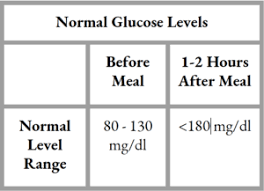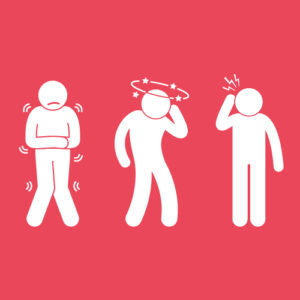Contents
- 1 What Is Normal Blood Sugar?
- 2 Symptoms Of High or Low Blood Sugar
- 3 How To Check Your Own Blood Sugar Level?
- 4 Ways To Control Your Blood Sugar Levels
- 5 When Should You Check Your Blood Sugar Levels?
- 6 How To Diagnose Blood Sugar Level?
- 7 Sugar And Your Body
- 8 What Happens If Blood Sugar Level Is Too High?
- 9 What Happens If The Blood Sugar Level Is Too Low?
- 10 A Word From MantraCare
What Is Normal Blood Sugar?
Normal blood sugar or blood glucose levels are between 80 and 130 mg/dL. That number is an average of what is normal for individuals with diabetes. When blood sugar levels are too high, the person may experience hyperglycemia. Hyperglycemia can be characterized by extreme thirst and urination, blurred vision, or shakiness, sweating, dizziness, or confusion. When the person has low blood glucose, they may experience hypoglycemia which can be characterized by sweating, dizziness, or confusion.
The range of normal blood glucose levels for people with diabetes is between 80-130 milligrams per deciliter (mg/dL). A person’s individual level will depend on many factors including how old they are, their ethnicity, their weight and height, and the activity they’ve performed recently.
Normal Range Of Blood Sugar Levels

The normal range of blood glucose levels for individuals with diabetes is between 80 and 130 milligrams per deciliter (mg/dL). When levels are too low, the person may experience hypoglycemia, which is characterized by shakiness, sweating, dizziness, or confusion. When blood sugar levels are too high, the person may experience hyperglycemia, which is characterized as extreme thirst and urination and blurred vision. Blood glucose levels can be checked by pricking a finger to get a drop of blood and putting it on a glucose meter.
The normal blood sugar range is between 80-120 mg/dL (3.9-6.7 mmol/L).
Symptoms Of High or Low Blood Sugar
When the person has low blood sugar, they may experience hypoglycemia which can be characterized by-

- Sweating
- Dizziness
- Confusion
- Lack of sleep
- Lack of Coordination
- Irritability
- Hunger
When sugar levels are too high, the person may experience hyperglycemia, which is characterized as-
- Extreme thirst
- Frequent urination
- Blurred vision
- Weakness
- Dry mouth
- Headache
People with type 2 diabetes may experience symptoms of high or low blood sugar. The levels can be checked by pricking a finger to get a drop of blood and putting it on a glucose meter.
How To Check Your Own Blood Sugar Level?
One way to check one’s own sugar level is by pricking a finger with a lancet and placing the blood that comes out onto a test strip, then inserting the strip into a glucose monitor. A meter can tell you what your levels are in about 5 seconds. Another option is by taking an oral glucose tolerance test (OGTT), which takes longer but may also provide more accurate results. A person’s individual level will depend on many factors including how old they are, their ethnicity, their weight and height, and the activity they’ve performed recently. Blood sugar levels can be checked by pricking a finger to get a drop of blood and putting it on a glucose meter.
Ways To Control Your Blood Sugar Levels
Ways individuals with diabetes can balance their blood sugar include keeping their weight in check, exercising regularly, following their medication and diet plans, and checking their blood sugar levels regularly. For some individuals, taking insulin shots may be necessary to keep glucose levels in check. Sticking to a schedule is important for individuals with diabetes. As it can help them regulate their blood sugar level.
However, just eating healthy and exercising regularly can help to a great extent. High fiber food, green vegetables, low GI fruits are all good food choices for people with diabetes. And exercises like Zumba, yoga, or just walking for 30 minutes every day can be very beneficial for bringing the blood sugar level back to normal.
When Should You Check Your Blood Sugar Levels?

It’s important that people who suspect they have diabetes or pre-diabetes monitor their glucose levels regularly, checking at least once daily and charting the results in order to know what is normal for themselves. If it seems like something isn’t quite right with one’s blood glucose. It may be time to talk to a doctor about getting a diabetes diagnosis. It’s also important that parents make sure their children are well aware of any symptoms of high or low blood sugar. So they know when they need to alert an adult about what might be going on if their parents are not around.
How To Diagnose Blood Sugar Level?
It’s possible to check your glucose level without a glucose meter by pricking your finger with a clean needle and putting the drop of blood on a strip that has been dipped in a special liquid. The strip will show your blood sugar level in both mg/dL and mmol/L.
A fasting blood glucose level is the amount of glucose in a person’s blood after they have not eaten for about 8 hours. The level is usually around 100 milligrams per deciliter (mg/dL). It’s possible to measure it using a glucose meter. 80-99 mg/dL (milligrams per deciliter) is the right amount of sugar to be present in the blood.
Sugar And Your Body

Sugar is a type of carbohydrate and is one of the key ingredients in many foods and drinks. It is a component that fills our daily quota and replaces other nutrients. The normal blood sugar range is between 70-120 mg/dL (3.9-6.7 mmol/L). The higher your blood glucose level, the more insulin your body produces to try to lower it. If you have diabetes, the levels of sugar in your blood are too high and do not come down on their own with the help of insulin production.
Diabetes is a lifelong condition. It occurs when the pancreas cannot make insulin or if the body cannot use its own insulin properly. Due to this, glucose builds up in your blood and does not reach your cells. It can lead to cardiovascular disease and nerve damage. Adding exercise and eating healthy can help with diabetes control and the prevention of secondary diseases.
Sugar substitutes are alternatives that provide the same sweetness as sugar but contain fewer calories than natural sugars do. They include saccharin, aspartame, sucralose, neotame, cyclamates (not available in Japan), stevia (Japan only), and alitame (not yet approved for use worldwide). Researchers are hoping glucose substitutes can replace sugar for people with diabetes.
What Happens If Blood Sugar Level Is Too High?

If your blood sugar levels are too high then you risk developing diabetes. You can develop cardiovascular disease and nerve damage. With diabetes, the glucose in your blood does not reach your cells and can lead to these and other complications. Adding exercise and eating healthy can help to control your diabetes and prevent secondary diseases.
You may develop diseases and disabilities in the future, such as cardiovascular disease and nerve damage, if you have diabetes.
If your blood sugar levels are high then you can develop diabetes and risk developing cardiovascular diseases and nerve damage. Doing exercise and eating healthy is important to control your diabetes and prevent secondary diseases.
Things To Do If You Have Diabetes
Common things that people with diabetes should avoid include eating lots of simple sugars, eating too much food for the activity they’ve performed recently, and not following medication or exercise plans.
Some things that can be harmful to people with diabetes are smoking cigarettes, drinking alcohol in excess, and eating large portions of unhealthy foods.
The person should maintain a healthy diet and exercise regularly. The doctor may also recommend taking insulin or other medications to manage their blood sugar levels.
What Happens If The Blood Sugar Level Is Too Low?
If your blood sugar levels are too low then you may feel-

- Extremely thirsty or hungry,
- Become pale with cold or clammy skin,
- Feel Irritable or tearful,
- Have a headache,
- Lose concentration at school/workplace,
- Have fluttering feelings outside of your chest (heart palpitations),
- Become confused want to sleep all the time,
- Dizzy spells faint at times
- Feel extra tired cramps in your hands or feet.
Have a condition that occurs in some people who have type 1 diabetes after they stop drinking alcohol. It also causes dizziness, confusion, heart palpitations, excessive tiredness, cramps, etc.
If your blood glucose levels are high then you can develop diabetes and risk developing cardiovascular diseases and nerve damage. Doing exercise and eating healthy is important to control your diabetes and prevent secondary diseases.
What To Do If You Have Low Blood Sugar?
If a person experiences hypoglycemia, they should consume something that contains glucose. Such as orange juice or hard candy before checking their blood sugar again. If it’s still below 70 mg/dL after consuming these products then medical assistance is advisable for this condition. Because their body needs insulin to change glucose into energy.
A Word From MantraCare
Do you want to get rid of diabetes? Join our online diabetes consultation program and reverse your Diabetes naturally through lifestyle changes such as a Personalized Diet plan, Exercise, dieticians, and health coaches.


